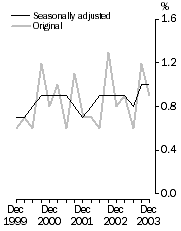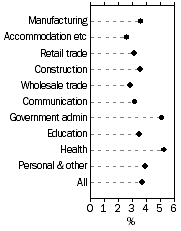December Key Figures
Quarterly changes

| Annual change: original, For selected industries

|
December Key Points
INDEXES OF TOTAL HOURLY RATES OF PAY EXCLUDING BONUSES
QUARTERLY CHANGES (SEP QTR 2003 TO DEC QTR 2003)
- The index for all employee jobs in Australia increased by 1.0%, seasonally adjusted.
- The increases in the indexes (in original terms) at the industry level ranged from 0.3% for Construction and Education to 1.6% for Government administration and defence.
- The increase in the indexes (in original terms) at the occupation level ranged from 0.6% for Professionals to 1.2% for Labourers and related workers.
ANNUAL CHANGES (DEC QTR 2002 TO DEC QTR 2003)
- The seasonally adjusted increase through the year to December 2003 for all employee jobs in Australia was 3.7%.
- Increases in the original indexes through the year to December 2003 at the industry level ranged from 2.6% for Accommodation, cafes and restaurants to 5.3% for Health and community services.
Notes
ABS DATA AVAILABLE ON REQUEST
Original indexes are compiled for various combinations of state/territory, sector (private/public), broad industry group and broad occupation group. Seasonally adjusted and trend indexes are only compiled for total hourly rates of pay excluding bonuses for the private sector, public sector and all sectors. Indexes not included in this publication may be made available on request by telephoning Perth (08) 9360 5151.
CHANGES IN THIS ISSUE
In April 2000, the ABS released an information paper, ABS Statistics and The New Tax System (cat.no. 1358.0), which foreshadowed changes in the statistical infrastructure supporting the compilation of ABS economic series. The main change impacting on the Wage Cost Index is the introduction of the Australian Business Register, maintained by the Australian Taxation Office, to provide details of the business population from which to select the sample of businesses.
This publication presents the first release of estimates from the Wage Cost Index compiled using the new infrastructure. As advised in the previous issue, this has not introduced any discontinuities into the WCI.
An information paper, Improvements in ABS Economic Statistics [Arising from The New Tax System] (cat.no. 1372.0), was released on 6 May 2002. That paper described the changes in more detail and provided information about the treatment of statistical impacts of the changes across ABS economic series.
FURTHER INFORMATION
More detailed information on the Wage Cost Index is available in Information Paper: Wage Cost Index, Australia, 2000 (cat. no. 6346.0).
Inquiries
For further information about these and related statistics, contact the National Information and Referral Service on 1300 135 070 or Tim Landrigan on Perth (08) 9360 5151.
Commentary
INFLUENCES ON THE WCI
The Safety Net Review decision was handed down by the Australian Industrial Relations Commission on 6 May 2003. Pay adjustments as a result of the Safety Net Review began to be implemented in all States and Territories except Queensland prior to the reference period for the September quarter WCI. The later implementation of the Safety Net Review in Queensland, and residual Safety Net Adjustments in other States and Territories contributed to the December quarter WCI.
The public sector original and seasonally adjusted annual movements were 4.8%, both up from 4.7% in the September quarter 2003. NSW public sector increases paid in the March and September quarters are contributing to the high annual movements for that State.
The pay mechanisms behind the increases in the private sector in order of significance were Collective Agreements, Salary reviews, and Awards. In the public sector, Collective Agreements were responsible for the majority of jobs reporting pay increases.
 Print Page
Print Page
 Print All
Print All